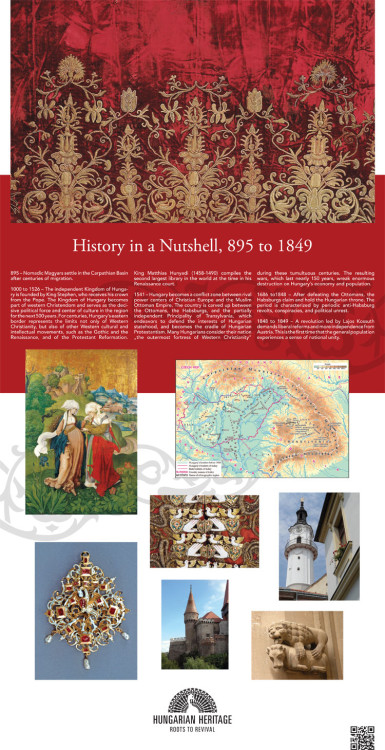895 – Nomadic Magyars settle in the Carpathian Basin after centuries of migration.
1000 to 1526 – The independent Kingdom of Hungary is founded by King Stephen, who receives his crown from the Pope. The Kingdom of Hungary becomes part of western Christendom and serves as the decisive political force and center of culture in the region for the next 500 years. For centuries, Hungary’s eastern border represents the limits not only of Western Christianity, but also of other Western cultural and intellectual movements, such as the Gothic and the Renaissance, and of the Protestant Reformation. King Matthias Hunyadi (1458-1490) compiles the second largest library in the world at the time in his Renaissance court.
1541 – Hungary becomes a conflict zone between rival power centers of Christian Europe and the Muslim Ottoman Empire. The country is carved up between the Ottomans, the Habsburgs, and the partially independent Principality of Transylvania, which endeavors to defend the interests of Hungarian statehood, and becomes the cradle of Hungarian Protestantism. Many Hungarians consider their nation „the outermost fortress of Western Christianity”during these tumultuous centuries. The resulting wars, which last nearly 150 years, wreak enormous destruction on Hungary’s economy and population. 1686 to1848 – After defeating the Ottomans, the Habsburgs claim and hold the Hungarian throne. The period is characterized by periodic anti-Habsburg revolts, conspiracies, and political unrest.
1848 to 1849 – A revolution led by Lajos Kossuth demands liberal reforms and more independence from Austria. This is the first time that the general population experiences a sense of national unity.
1867 – The so-called Compromise transforms the Habsburg Empire into the dual monarchy of Austria- Hungary. The Hungarian capital city of Budapest rises to become a true metropolis.
1914 to 1918 – Austria-Hungary takes part in World War I and suffers enormous human losses. After the war, the dual monarchy collapses.
1920 – The Trianon Treaty ends the territorial integrity of the old Kingdom of Hungary reducing the area of Hungary by two-thirds and the population by half. One-third of the ethnic Hungarians come under the rule of neighboring states.
1920 to 1944 – After the Great War, Hungary is consolidated under the semi-parliamentary regime of Miklós Horthy. While political freedoms are limited, the cultural and scientific life of the era is rich. Seeking to reclaim territories lost after World War I, Hungary allies with Germany and enters World War II. The number of victims of the war are almost one million people, including half a million Jews.
1945 to 1956 – After a brief democratic experiment, the Communist Party, with the support of the Soviet Union seizes power. In the first half of the 1950s, Mátyás Rákosi imposes a Stalinist dictatorship.
1956 – A revolution breaks out on 23 October 1956 against the totalitarian dictatorship. Suppressed by the Soviet army, the revolution is followed by a period of bloody repression.
1956 to 1988 – János Kádár re-establishes one-party Communist rule. From the middle of the 1960s, a more liberal form of state socialism emerges.
1989 – The collapse of Communism. A multi-party parliamentary democracy is established, and free elections are held in 1990. In 1999, Hungary becomes a full member of NATO and joins the EU in 2004.
Related page:








